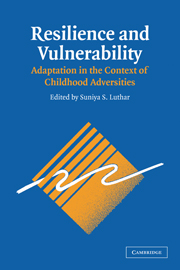Book contents
- Frontmatter
- Contents
- List of Contributors
- Foreword by Dante Cicchetti
- Preface
- 1 A Resilience Framework for Research, Policy, and Practice
- PART I FAMILIAL ADVERSITIES: PARENTAL PSYCHOPATHOLOGY AND FAMILY PROCESSES
- PART II EXOSYSTEMIC AND SOCIODEMOGRAPHIC RISKS
- 10 Rethinking Resilience: A Developmental Process Perspective
- 11 Poverty and Early Childhood Adjustment
- 12 Emerging Perspectives on Context Specificity of Children's Adaptation and Resilience: Evidence from a Decade of Research with Urban Children in Adversity
- 13 Holistic Contextual Perspectives on Risk, Protection, and Competence among Low-Income Urban Adolescents
- 14 Overcoming the Odds? Adolescent Development in the Context of Urban Poverty
- 15 Adaptation among Youth Facing Multiple Risks: Prospective Research Findings
- 16 Positive Adaptation among Youth Exposed to Community Violence
- 17 Perceived Discrimination and Resilience
- 18 Promoting Resilience through Early Childhood Intervention
- PART III COMMENTARIES
- Index
- References
16 - Positive Adaptation among Youth Exposed to Community Violence
Published online by Cambridge University Press: 05 June 2012
- Frontmatter
- Contents
- List of Contributors
- Foreword by Dante Cicchetti
- Preface
- 1 A Resilience Framework for Research, Policy, and Practice
- PART I FAMILIAL ADVERSITIES: PARENTAL PSYCHOPATHOLOGY AND FAMILY PROCESSES
- PART II EXOSYSTEMIC AND SOCIODEMOGRAPHIC RISKS
- 10 Rethinking Resilience: A Developmental Process Perspective
- 11 Poverty and Early Childhood Adjustment
- 12 Emerging Perspectives on Context Specificity of Children's Adaptation and Resilience: Evidence from a Decade of Research with Urban Children in Adversity
- 13 Holistic Contextual Perspectives on Risk, Protection, and Competence among Low-Income Urban Adolescents
- 14 Overcoming the Odds? Adolescent Development in the Context of Urban Poverty
- 15 Adaptation among Youth Facing Multiple Risks: Prospective Research Findings
- 16 Positive Adaptation among Youth Exposed to Community Violence
- 17 Perceived Discrimination and Resilience
- 18 Promoting Resilience through Early Childhood Intervention
- PART III COMMENTARIES
- Index
- References
Summary
Exposure to community violence threatens the well-being of children in several ways. Living in communities plagued by violence threatens the very core of what is needed for healthy development and is related to a host of short- and long-term developmental problems (Bell & Jenkins, 1993; Cooley-Quill, Boyd, Frantz, & Walsh, 2001; Gorman-Smith & Tolan, 1998; Richters & Martinez, 1993; Schwab-Stone et al., 1995). Unfortunately, although it is possible to list many problems and disorders associated with exposure to community violence, we can say very little based on scientific study about variations in outcome, relations between specific types of exposure and outcome, and mechanisms through which children who are exposed do better or worse. We know that some children appear to suffer symptoms of posttraumatic stress disorder or other types of internalizing disorders, and others seem to react by becoming more aggressive or showing greater behavioral problems. However, we know little about how and why these different reactions occur. We also have few empirically based treatments for children exposed to chronic community violence, and even less work has been conducted on how to protect children from exposure in the first place. So, although it is clear that exposure to community violence can harm children, the scientific knowledge base on promoting positive adaptation among youth exposed to community violence is very sketchy.
- Type
- Chapter
- Information
- Resilience and VulnerabilityAdaptation in the Context of Childhood Adversities, pp. 392 - 413Publisher: Cambridge University PressPrint publication year: 2003
References
- 27
- Cited by



